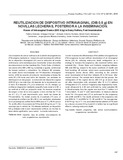Reutilización de dispositivo intravaginal (dib 0,5 g) en novillas lecheras, posterior a la inseminación.

View/
Date
2016-07Author
Palabras Clave
Implante, Tasa de preñez, Sincronización de celo, Progesterona, ReproducciónImplant, Pregnancy rate, Estrus synchronization, Progesterone, Reproduction
Metadata
Show full item recordAbstract
Con el objetivo de valorar la eficacia de la adición de progesterona (P4) exógena
mediante la reinserción post inseminación artificial de un dispositivo intravaginal (DI) para la
reducción de muerte embrionaria, como estrategia para incrementar la tasa de preñez se
seleccionaron novillas mestizas (Gyr, Pardo Suizo y Holstein), con pesos entre 300 y 350 kg,
sometidas a iguales condiciones de manejo sanitario y alimenticio. Se utilizaron 40 animales,
los cuales fueron sincronizadas con P4 dispositivo intravaginal bovino (DIB) de acuerdo al
protocolo; inseminadas a tiempo fijo entre 53 a 54 horas post retiro del implante. Los animales
se distribuyeron en dos grupos: la reinserción del dispositivo vaginal (DIB 0,5 g) a los siete
días (d) después de la inseminación con el retiro 10 d después (T1) y sin reinserción DI (T2,
testigo). La preñez se diagnosticó mediante ecografía trans-rectal al d 30 y se confirmó al d 60
por palpación rectal. Se tomaron muestras de sangre a nivel de la vena yugular a cinco novillas
del T1 en los d 7; 12 y 17 post inseminación, para medir los niveles de P4 plasmática. Se
realizó prueba de Ji-cuadrado (X²) para el porcentaje de preñez a los 30 y 60 d. Los resultados
alcanzados en el porcentaje de preñez fueron 60% para el T1 y 50 % para el T2, en 30 y 60 d. El
promedio de P4 fue de 8,33 ng /mL en T1. Se concluye que la adición de P4 utilizada mediante un
dispositivo 0,5 g utilizado siete d post inseminación artificial, en novillas no tiene efecto
significativo para reducir la muerte embrionaria.
Collections
Información Adicional
| Otros Títulos | Reuse of intravaginal device (idb 0.5g) in dairy heifers, post insemination. |
| Correo Electrónico | fatimitaespam@yahoo.es |
| Editor | SABER-ULA |
| ISSN | 0798-2259 |
| ISSN Electrónico | 2477-944X |
| Resumen en otro Idioma | In order to assess the effectiveness of the addition of progesterone (P4) exogenous by post artificial insemination of an intravaginal device (ID) for reducing embryonic death reintegration as a strategy to increase the pregnancy rate crossbred heifers were selected (Gyr , Brown Swiss and Holstein), weighing between 300 and 350 kg, subject to the same conditions of health and food handling. 40 animals, which were synchronized with P4 intravaginal bovine device (IBD) according to the protocol used; inseminated at fixed time between 53 to 54 hours after implant removal. The animals were divided into two groups: the reintegration of the vaginal device (IBD 0.5 g) at seven days (d) after insemination with retirement after 10 d (T1) without reintegration DI (T2, control). Pregnancy was diagnosed by transrectal ultrasound to d 30 and confirmed by rectal palpation 60 d. Blood samples from the jugular vein level five T1 heifers in d 7 were taken; 12 and 17 post insemination, to measure plasma levels P4. Chi-square test (X²) is performed for the pregnancy rate at 30 and 60 d. The results achieved in the pregnancy rate was 60% for T1 and 50% for T2, 30 and 60 d. The average was 8.33 P4 ng / mL in T1. It is concluded that the addition of P4 used by a device on seven 0.5 g d post AI in heifers has no significant effect in reducing embryonic death. |
| Colación | 247 - 251 |
| País | Venezuela |
| Institución | Universidad del Zulia (LUZ) Universidad de Los Andes (ULA) |
| Publicación Electrónica | Revista Científica |
| Sección | Producción animal |





